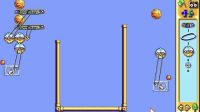
The Incredible Machine 2, released in 1994 for DOS, is a delightful upgrade to its predecessor, delivering even more complex and creative puzzle-solving mayhem. Developed by Jeff Tunnell Productions and published by Sierra On-Line, the game tasks players with completing unfinished Rube Goldberg-style contraptions using a toolbox full of quirky parts—from lava lamps and leaky buckets to monkeys on treadmills. With over 150 puzzles, a robust puzzle editor, and two-player Head-to-Head mode, this title is a masterpiece of logical chaos and whimsical invention.
How to play The Incredible Machine 2
Objective and Gameplay
The main objective is to complete pre-designed machines by adding missing parts in just the right places. Each level has a specific goal—like popping a balloon or getting a mouse to its hole—and a set of provided tools. The machines are wonderfully absurd, and the game challenges you to think creatively within the bounds of real-world physics and interactions between objects.
Controls & Interface
- Mouse: The entire interface is mouse-driven. Drag and drop parts from the Parts Bin into the Playfield.
- Keyboard: Shortcuts allow quick access to features, rotating parts, or accessing menus.
- DOS Emulated Play: Best experienced on desktop with mouse support; mobile support varies and may hinder precision.
Game Modes
Puzzle Play: Includes 150+ puzzles that scale from tutorial-level simplicity to diabolical brain-busters. Use the Control Panel to load puzzles, view hints, adjust music, or change backgrounds.
Professor Tim’s Workshop: Create your own puzzles from scratch using the full arsenal of game parts. Build machines for fun, or design puzzles with missing pieces for others to solve. Save and share your homemade puzzles with friends.
Head-to-Head Mode: Compete against a friend in turn-based puzzle duels, where strategy and timing are key. One part per move—plan wisely!
Parts and Programming
The Parts Bin is filled with mechanical and whimsical items. Some of the highlights include:
- Ropes, pulleys, and steel cables: For hoisting, pulling, and triggering objects
- Electrical components: Fans, toasters, light bulbs, and laser beams
- Programmable parts: Change physical properties like mass, elasticity, friction
- Biological components: Cats, mice, monkeys, and humans—all with unique reactions
- Explosives and fuses: Use dynamite, rockets, and lasers to trigger chain reactions
Custom Puzzles & Creativity
In Professor Tim’s Workshop, you can:
- Adjust gravity and atmospheric pressure
- Design scenery and background elements
- Add music and sound effects
- Lock/unlock parts and provide solution criteria
- Program puzzles to recognize when goals are achieved
FAQ
What’s new in The Incredible Machine 2 compared to the first game?
It introduces programmable parts, an enhanced interface, improved physics, and 150+ puzzles. It also features better graphics and a vastly more powerful puzzle editor.
Can I play with a friend?
Yes! The Head-to-Head mode lets you and a friend compete by taking turns placing or moving parts within a set time limit.
How do I know if I’ve solved a puzzle correctly?
The machine must complete the objective successfully when the green flag is clicked. If it does, you’re rewarded with celebratory animations and can move on or replay.
Are all parts realistic?
While grounded in basic physics, many parts are whimsical and humorous. The game emphasizes fun over realism—expect monkeys on treadmills powering fans and candles triggering coffee pots.
Can I make my own puzzles?
Absolutely! The Workshop lets you build machines from scratch, set goals, create hints, and save them as playable puzzles.
Are the puzzles linear?
No, many puzzles have multiple possible solutions. Creativity and experimentation are strongly encouraged.
What are programmable parts?
Certain components, like the programmable ball or leaky bucket, let you alter properties like mass, density, or delay timers, allowing for complex and custom machine behavior.
How is physics simulated?
Gravity, pressure, density, elasticity, and friction are all part of the physics engine, ensuring consistent cause-and-effect interactions with no random variation.
What types of puzzle goals exist?
They range from guiding an object to a location, popping balloons, turning on devices, or completing chains of interaction like lighting a rocket with a candle via a magnifying glass.
How many puzzle difficulty levels are there?
Seven total categories: Easy, Medium, Hard, Really Hard, Tutorial, Head-to-Head, and Homemade. Players can pick any level from the Load Menu.
Game Fodder
Manuals
Videos
Full Walkthrough: The Incredible Machine 2 longplay
